2023年中考英语阅读理解解题思路课件(共24张PPT)
文档属性
| 名称 | 2023年中考英语阅读理解解题思路课件(共24张PPT) | 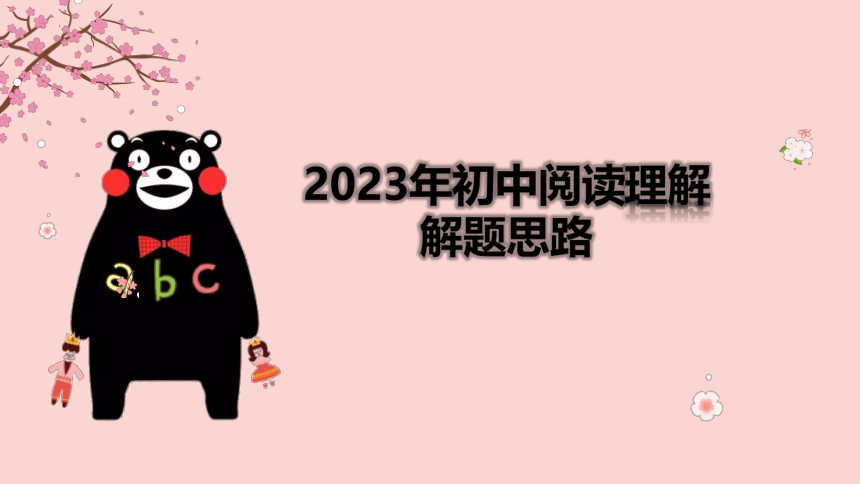 | |
| 格式 | zip | ||
| 文件大小 | 5.3MB | ||
| 资源类型 | 教案 | ||
| 版本资源 | 人教新目标(Go for it)版 | ||
| 科目 | 英语 | ||
| 更新时间 | 2023-03-31 14:14:42 | ||
图片预览

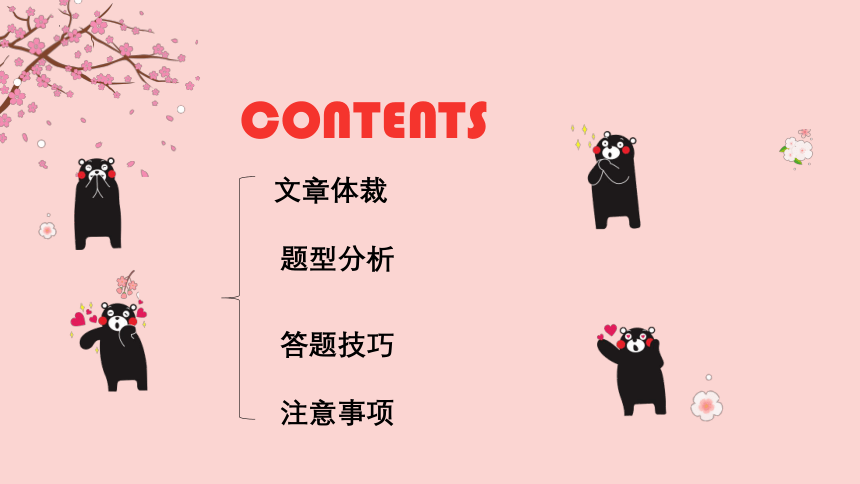

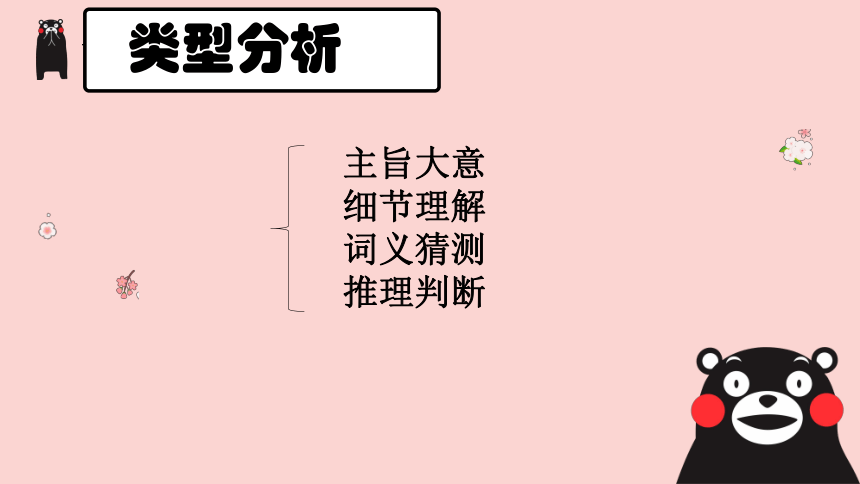
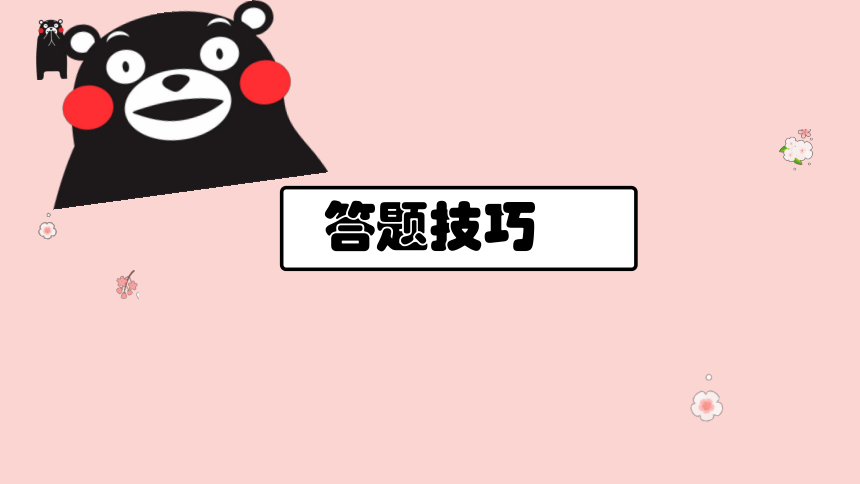
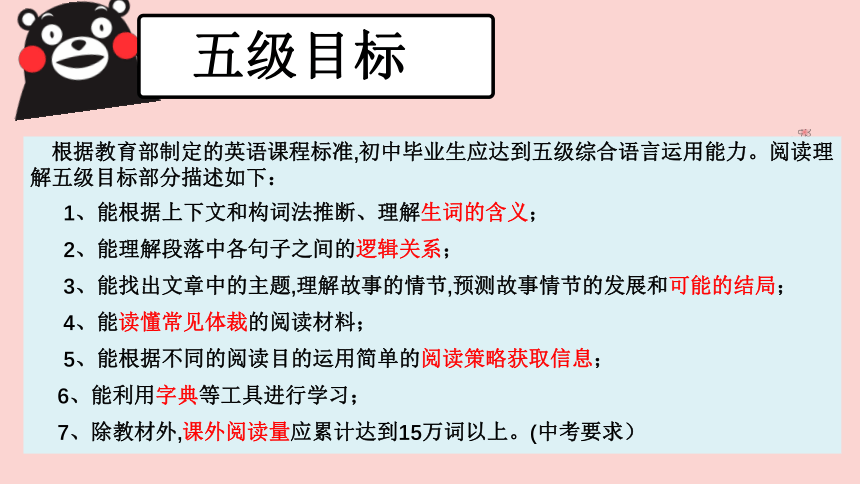
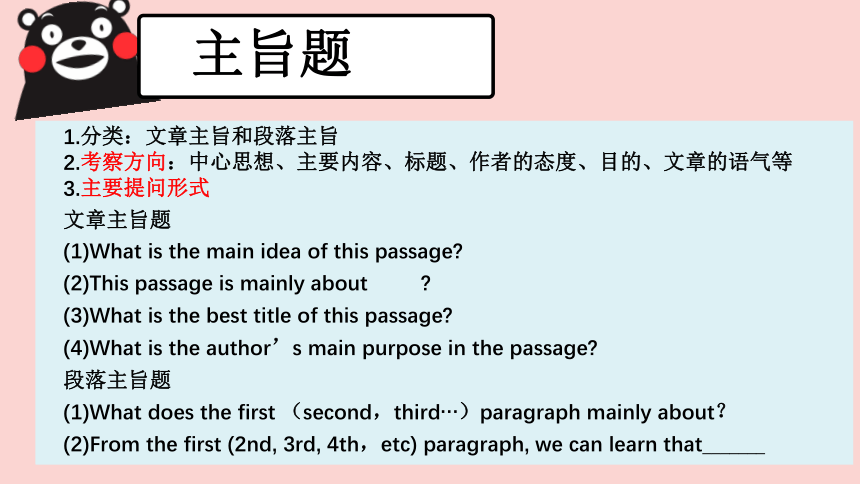
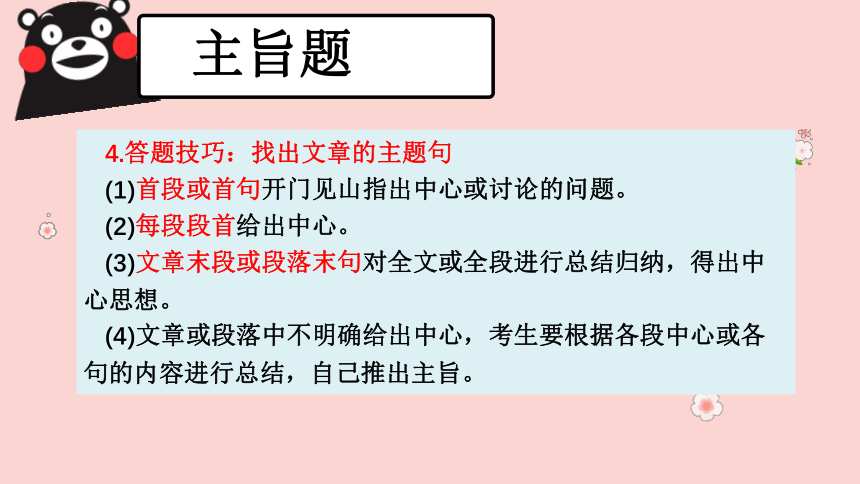
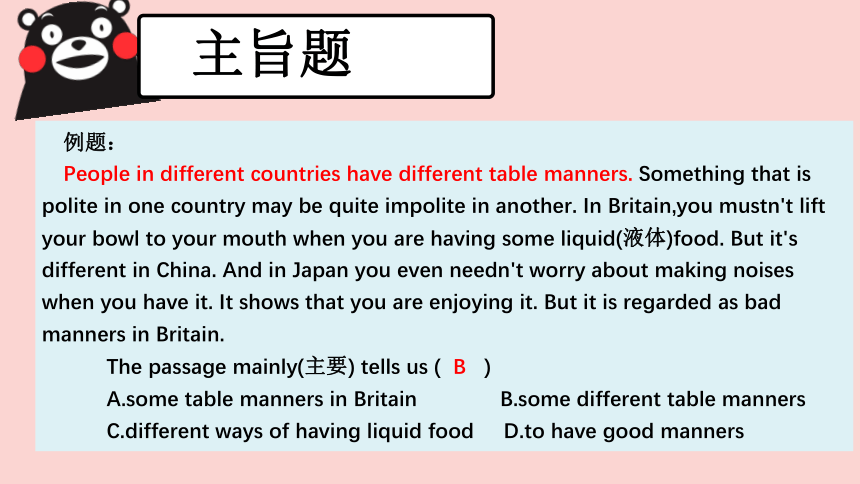
文档简介
(共24张PPT)
2023年初中阅读理解
解题思路
CONTENTS
文章体裁
答题技巧
题型分析
注意事项
文章体裁
阅读理解文章的体裁主要有四类:记叙文、说明文、应用文和议论文
1)记叙文
叙述文一般以讲述个人生活经历为主,对于经历的陈述通常由一定的时间概念贯穿其中,或顺序或倒序。
2)说明文
说明文是以说明为主要表达方式来解说事物、阐明事理而给人知识的文章体裁。
3)应用文
所谓应用文是人们在生活、学习、工作中为处理实际事物而写作,有着实用性特点,并形成惯用格式的文章。
4)议论文
议论文是对某个问题或某件事进行分析、评论,表明自己的观点、立场、态度、看法和主张的一种文体。
类型分析
主旨大意
细节理解
词义猜测
推理判断
答题技巧
五级目标
根据教育部制定的英语课程标准,初中毕业生应达到五级综合语言运用能力。阅读理解五级目标部分描述如下:
1、能根据上下文和构词法推断、理解生词的含义;
2、能理解段落中各句子之间的逻辑关系;
3、能找出文章中的主题,理解故事的情节,预测故事情节的发展和可能的结局;
4、能读懂常见体裁的阅读材料;
5、能根据不同的阅读目的运用简单的阅读策略获取信息;
6、能利用字典等工具进行学习;
7、除教材外,课外阅读量应累计达到15万词以上。(中考要求)
主旨题
1.分类:文章主旨和段落主旨
2.考察方向:中心思想、主要内容、标题、作者的态度、目的、文章的语气等
3.主要提问形式
文章主旨题
(1)What is the main idea of this passage
(2)This passage is mainly about
(3)What is the best title of this passage
(4)What is the author’s main purpose in the passage
段落主旨题
(1)What does the first (second,third…)paragraph mainly about?
(2)From the first (2nd, 3rd, 4th,etc) paragraph, we can learn that_______
主旨题
4.答题技巧:找出文章的主题句
(1)首段或首句开门见山指出中心或讨论的问题。
(2)每段段首给出中心。
(3)文章末段或段落末句对全文或全段进行总结归纳,得出中 心思想。
(4)文章或段落中不明确给出中心,考生要根据各段中心或各句的内容进行总结,自己推出主旨。
主旨题
例题:
People in different countries have different table manners. Something that is polite in one country may be quite impolite in another. In Britain,you mustn't lift your bowl to your mouth when you are having some liquid(液体)food. But it's different in China. And in Japan you even needn't worry about making noises when you have it. It shows that you are enjoying it. But it is regarded as bad manners in Britain.
The passage mainly(主要) tells us ( B )
A.some table manners in Britain B.some different table manners
C.different ways of having liquid food D.to have good manners
细节题
1.考查方向:把握文章的事实和细节的能力,注重细节或事实
涉及内容广:时间、地点、人物、数字、原因、结果、文字结构等2.考察方向:中心思想、主要内容、标题、作者的态度、目的、文章的语气等
2. 常见提问形式:
(1) According to the passage, when/where/what / who/how/why…
(2) Which of the following statements is TRUE
(3)According to the passage, all of the following are true EXCEPT…
(4) Which of the following is not mentioned
(5) Which of the following is Not True in the passage
(6) Choose the right order of this passage.
(7) From this passage we know ________.
细节题
3.做题方法:
(1)定位:根据问题,找到文中出现位置,找出相应的信息点。
(问题信息点:人物,时间,地点,所给中文,动词+事件,特殊名词)
(2)明确信息点:弄清楚人物对象,时间,地点,所出现的事物,否定词等,一一对应排除。
(3)具体信息点支撑:找到文中具体对应信息点,切记主观臆断
(4)文章太长时,先看问题,一一对应排除,提高正确率和做题效率。
细节题
例:What do you think of your teachers Now, American students can say what they think on a new website!
On www., students can rate (评定) their teachers. So far, there have been 2 million ratings for 365,000 teachers at 21,000 schools in the US and Canada.
Where can the students rate(评定) their teachers according to the passage ( A )
A.On www. B.At the class meeting
C.In the classroom.
词义猜测
1.考查方向:根据上下文猜测生词的含义的能力。
猜测题是阅读理解部分常见的一个测试项目,一是超纲词含义的推断,另一个是熟词僻义或是在特定场合的意思。
2. 常见提问形式:
(1) The word “______” in the passage probably means ________.
(2) The underlined word “It” in the passage refers to _______.
(3) In this story the underlined word “_______” means ________.
(4) Here “it” means________.
词义猜测
3.做题技巧:
(1)前后句及上下文进行猜测。注意与这个词紧密相连的前后几个词语的意思,前后文所带感彩,以及连词。
(2)利用构词法来进行猜测。常用的构词法有派生法,转化法以及合成法。Man-made ,part-time.
例子:
There are four seasons in a year. They are spring, summer, autumn and winter.
Spring is a beautiful season. It’s from March to May. In spring, the trees turn green, and the flowers come out, everything looks new.
( )67. What’s the meaning of the underlined (下划线) words
A.出来 B. 开花 C.出版 D. 鲜艳
推理题
1.考查方向:对文章及各段,各句之间的逻辑关系的理解能力。
(1)要求考生脱离字面理解的局限,透过文章的字里行间,对作者的话进行推理判断,从而获得对文章的深层理解。
(2)答案往往在文章的字面上不会出现,必须依据已有信息来进行推理,不能脱离原文去主观臆断。因此,在做推理题时,必须从原文里找到推断的依据。
推理题
2. 类型:
(1)事实推断
针对某一个或几个具体细节,比较简单。这种推断,要首先在文章中找出据以推断的有关文字,然后加以分析,尤其要悟出字里行间的意思。
(2)逻辑推断
要求根据文章所提供的背景,人物的表情,动作和语言来推断出人物的态度或感觉。
(3)意图和态度的推断
要求考生就作者对论述对象持什么样的态度做出推断,如作者对所陈述的观点是赞同、反对,还是犹豫不定,对记述或描写的人、物或事件是赞颂、同情、冷漠,还是厌恶。作者的这种思想倾向和感彩不一定直接表述出来,而往往隐含在字里行间。
推理题
3. 常见提问形式
(1) We can learn from this passage that…
(2) We can conclude from the passage that…
(3) It can be seen from the passage that…
(4) What is the real meaning of the doctors’ words
(5) Many visitors come to the writer’s city to ________.
(6) Air pollution is the most serious kind of pollution because _____.
(7) Why did the writer get off the train two stops before Vienna station
推理题
3. 做题技巧:
(1)注意文章主题思想,和作者的措辞,尤其是形容词一类的修饰语
(2)注意文中的观点态度和表达感情的词语和句子,如:sad,happy,agree,I think...等。
例题:
Mrs. Hunt comes back from work. She tells Mr. Hunt about a nice dress. "I see it in the shop every day." she says. "And...."
"And do you want to buy it " asks Mr. Hunt. "How much is it "
"It's two hundred and sixty dollars," Mrs. Hunt answers.
"Is two hundred and sixty dollars for a dress That's too much!"says Mr. Hunt.
But every evening when she comes back, Mrs. Hunt only talks about the dress. So at last Mr. Hunt says , "Oh , you can buy it! Here's the money! ". Mrs. Hunt is very happy. The next evening, Mr. Hunt wants to have a look at the nice dress, but Mrs. Hunt says. "I don't want to buy it. "
"Why not " he asks.
"Well, it is still in the window of the shop after a week. So I think no one wants this dress. And I don't want it, either."
( D ) 5. Mrs. Hunt doesn't want to buy the dress at last because she thinks ______.
A. it is much too expensive B. it is not very new
C. it is much too old D. it is not very good
推理题
例:
Mrs. Hunt comes back from work. She tells Mr. Hunt about a nice dress. "I see it in the shop every day." she says. "And...."
"And do you want to buy it " asks Mr. Hunt. "How much is it "
"It's two hundred and sixty dollars," Mrs. Hunt answers.
"Is two hundred and sixty dollars for a dress That's too much!"says Mr. Hunt.
But every evening when she comes back, Mrs. Hunt only talks about the dress. So at last Mr. Hunt says , "Oh , you can buy it! Here's the money! ". Mrs. Hunt is very happy. The next evening, Mr. Hunt wants to have a look at the nice dress, but Mrs. Hunt says. "I don't want to buy it.
推理题
例题:
"Why not " he asks.
"Well, it is still in the window of the shop after a week. So I think no one wants this dress. And I don't want it, either."
( D ) 5. Mrs. Hunt doesn't want to buy the dress at last because she thinks ______.
A. it is much too expensive B. it is not very new
C. it is much too old D. it is not very good
解题注意事项
1.忌不带问题
做阅读理解题时,应先把文章后面所给的考查问题浏览一遍,然后带着这些问题进行阅读。边阅读边选出考查表层情况问题的答案,从而提高阅读效果。
2.忌草率行事
在设计理解题时,设计者往往在四个选项中设计出一个似是而非的答案。这样答案干扰性特别强,容易迷惑考生。如果在发现一个看似正确答案时就草率定案,往往会掉进设计者设置的“陷阱”里。处理的方法是:对所给四个备选答案进行分析比较,在理解理解阅读材料内容的基础上进行去伪存真,方可选出正确答案。
解题注意事项
3.忌主观印象
少数阅读不明确题只需根据生活常识就可选出答案,而绝大多数则不然,考生必须按照原文来选定答案。因此,考生在做后一种测试题时,一定要排除自身的生活经验、经历和已有的知识等主观因素的干扰,按照文章实际反映的情况来选择答案。
4. 忌忽略时间
做阅读理解题时,一定要从整体上控制时间,时间分配根据文章的难易程度有别。文中一两处没弄懂的地方可以暂且放置一边,等把全部题做完后,再回头来处理。因为做完题后,你的心情相对放松了往往会产生新的思路、新的灵感。即使做完题后时间所剩无几了,你再把未处理的题猜测一下也不晚,因为你仍然有选对的可能性。
解题步骤
1.浏览问题,定位信息,理解句意
2.带问题,找答案,排除干扰项,提高正确率
3.找信息依据,支撑选项,不主观臆断
THANKS
2023年初中阅读理解
解题思路
CONTENTS
文章体裁
答题技巧
题型分析
注意事项
文章体裁
阅读理解文章的体裁主要有四类:记叙文、说明文、应用文和议论文
1)记叙文
叙述文一般以讲述个人生活经历为主,对于经历的陈述通常由一定的时间概念贯穿其中,或顺序或倒序。
2)说明文
说明文是以说明为主要表达方式来解说事物、阐明事理而给人知识的文章体裁。
3)应用文
所谓应用文是人们在生活、学习、工作中为处理实际事物而写作,有着实用性特点,并形成惯用格式的文章。
4)议论文
议论文是对某个问题或某件事进行分析、评论,表明自己的观点、立场、态度、看法和主张的一种文体。
类型分析
主旨大意
细节理解
词义猜测
推理判断
答题技巧
五级目标
根据教育部制定的英语课程标准,初中毕业生应达到五级综合语言运用能力。阅读理解五级目标部分描述如下:
1、能根据上下文和构词法推断、理解生词的含义;
2、能理解段落中各句子之间的逻辑关系;
3、能找出文章中的主题,理解故事的情节,预测故事情节的发展和可能的结局;
4、能读懂常见体裁的阅读材料;
5、能根据不同的阅读目的运用简单的阅读策略获取信息;
6、能利用字典等工具进行学习;
7、除教材外,课外阅读量应累计达到15万词以上。(中考要求)
主旨题
1.分类:文章主旨和段落主旨
2.考察方向:中心思想、主要内容、标题、作者的态度、目的、文章的语气等
3.主要提问形式
文章主旨题
(1)What is the main idea of this passage
(2)This passage is mainly about
(3)What is the best title of this passage
(4)What is the author’s main purpose in the passage
段落主旨题
(1)What does the first (second,third…)paragraph mainly about?
(2)From the first (2nd, 3rd, 4th,etc) paragraph, we can learn that_______
主旨题
4.答题技巧:找出文章的主题句
(1)首段或首句开门见山指出中心或讨论的问题。
(2)每段段首给出中心。
(3)文章末段或段落末句对全文或全段进行总结归纳,得出中 心思想。
(4)文章或段落中不明确给出中心,考生要根据各段中心或各句的内容进行总结,自己推出主旨。
主旨题
例题:
People in different countries have different table manners. Something that is polite in one country may be quite impolite in another. In Britain,you mustn't lift your bowl to your mouth when you are having some liquid(液体)food. But it's different in China. And in Japan you even needn't worry about making noises when you have it. It shows that you are enjoying it. But it is regarded as bad manners in Britain.
The passage mainly(主要) tells us ( B )
A.some table manners in Britain B.some different table manners
C.different ways of having liquid food D.to have good manners
细节题
1.考查方向:把握文章的事实和细节的能力,注重细节或事实
涉及内容广:时间、地点、人物、数字、原因、结果、文字结构等2.考察方向:中心思想、主要内容、标题、作者的态度、目的、文章的语气等
2. 常见提问形式:
(1) According to the passage, when/where/what / who/how/why…
(2) Which of the following statements is TRUE
(3)According to the passage, all of the following are true EXCEPT…
(4) Which of the following is not mentioned
(5) Which of the following is Not True in the passage
(6) Choose the right order of this passage.
(7) From this passage we know ________.
细节题
3.做题方法:
(1)定位:根据问题,找到文中出现位置,找出相应的信息点。
(问题信息点:人物,时间,地点,所给中文,动词+事件,特殊名词)
(2)明确信息点:弄清楚人物对象,时间,地点,所出现的事物,否定词等,一一对应排除。
(3)具体信息点支撑:找到文中具体对应信息点,切记主观臆断
(4)文章太长时,先看问题,一一对应排除,提高正确率和做题效率。
细节题
例:What do you think of your teachers Now, American students can say what they think on a new website!
On www., students can rate (评定) their teachers. So far, there have been 2 million ratings for 365,000 teachers at 21,000 schools in the US and Canada.
Where can the students rate(评定) their teachers according to the passage ( A )
A.On www. B.At the class meeting
C.In the classroom.
词义猜测
1.考查方向:根据上下文猜测生词的含义的能力。
猜测题是阅读理解部分常见的一个测试项目,一是超纲词含义的推断,另一个是熟词僻义或是在特定场合的意思。
2. 常见提问形式:
(1) The word “______” in the passage probably means ________.
(2) The underlined word “It” in the passage refers to _______.
(3) In this story the underlined word “_______” means ________.
(4) Here “it” means________.
词义猜测
3.做题技巧:
(1)前后句及上下文进行猜测。注意与这个词紧密相连的前后几个词语的意思,前后文所带感彩,以及连词。
(2)利用构词法来进行猜测。常用的构词法有派生法,转化法以及合成法。Man-made ,part-time.
例子:
There are four seasons in a year. They are spring, summer, autumn and winter.
Spring is a beautiful season. It’s from March to May. In spring, the trees turn green, and the flowers come out, everything looks new.
( )67. What’s the meaning of the underlined (下划线) words
A.出来 B. 开花 C.出版 D. 鲜艳
推理题
1.考查方向:对文章及各段,各句之间的逻辑关系的理解能力。
(1)要求考生脱离字面理解的局限,透过文章的字里行间,对作者的话进行推理判断,从而获得对文章的深层理解。
(2)答案往往在文章的字面上不会出现,必须依据已有信息来进行推理,不能脱离原文去主观臆断。因此,在做推理题时,必须从原文里找到推断的依据。
推理题
2. 类型:
(1)事实推断
针对某一个或几个具体细节,比较简单。这种推断,要首先在文章中找出据以推断的有关文字,然后加以分析,尤其要悟出字里行间的意思。
(2)逻辑推断
要求根据文章所提供的背景,人物的表情,动作和语言来推断出人物的态度或感觉。
(3)意图和态度的推断
要求考生就作者对论述对象持什么样的态度做出推断,如作者对所陈述的观点是赞同、反对,还是犹豫不定,对记述或描写的人、物或事件是赞颂、同情、冷漠,还是厌恶。作者的这种思想倾向和感彩不一定直接表述出来,而往往隐含在字里行间。
推理题
3. 常见提问形式
(1) We can learn from this passage that…
(2) We can conclude from the passage that…
(3) It can be seen from the passage that…
(4) What is the real meaning of the doctors’ words
(5) Many visitors come to the writer’s city to ________.
(6) Air pollution is the most serious kind of pollution because _____.
(7) Why did the writer get off the train two stops before Vienna station
推理题
3. 做题技巧:
(1)注意文章主题思想,和作者的措辞,尤其是形容词一类的修饰语
(2)注意文中的观点态度和表达感情的词语和句子,如:sad,happy,agree,I think...等。
例题:
Mrs. Hunt comes back from work. She tells Mr. Hunt about a nice dress. "I see it in the shop every day." she says. "And...."
"And do you want to buy it " asks Mr. Hunt. "How much is it "
"It's two hundred and sixty dollars," Mrs. Hunt answers.
"Is two hundred and sixty dollars for a dress That's too much!"says Mr. Hunt.
But every evening when she comes back, Mrs. Hunt only talks about the dress. So at last Mr. Hunt says , "Oh , you can buy it! Here's the money! ". Mrs. Hunt is very happy. The next evening, Mr. Hunt wants to have a look at the nice dress, but Mrs. Hunt says. "I don't want to buy it. "
"Why not " he asks.
"Well, it is still in the window of the shop after a week. So I think no one wants this dress. And I don't want it, either."
( D ) 5. Mrs. Hunt doesn't want to buy the dress at last because she thinks ______.
A. it is much too expensive B. it is not very new
C. it is much too old D. it is not very good
推理题
例:
Mrs. Hunt comes back from work. She tells Mr. Hunt about a nice dress. "I see it in the shop every day." she says. "And...."
"And do you want to buy it " asks Mr. Hunt. "How much is it "
"It's two hundred and sixty dollars," Mrs. Hunt answers.
"Is two hundred and sixty dollars for a dress That's too much!"says Mr. Hunt.
But every evening when she comes back, Mrs. Hunt only talks about the dress. So at last Mr. Hunt says , "Oh , you can buy it! Here's the money! ". Mrs. Hunt is very happy. The next evening, Mr. Hunt wants to have a look at the nice dress, but Mrs. Hunt says. "I don't want to buy it.
推理题
例题:
"Why not " he asks.
"Well, it is still in the window of the shop after a week. So I think no one wants this dress. And I don't want it, either."
( D ) 5. Mrs. Hunt doesn't want to buy the dress at last because she thinks ______.
A. it is much too expensive B. it is not very new
C. it is much too old D. it is not very good
解题注意事项
1.忌不带问题
做阅读理解题时,应先把文章后面所给的考查问题浏览一遍,然后带着这些问题进行阅读。边阅读边选出考查表层情况问题的答案,从而提高阅读效果。
2.忌草率行事
在设计理解题时,设计者往往在四个选项中设计出一个似是而非的答案。这样答案干扰性特别强,容易迷惑考生。如果在发现一个看似正确答案时就草率定案,往往会掉进设计者设置的“陷阱”里。处理的方法是:对所给四个备选答案进行分析比较,在理解理解阅读材料内容的基础上进行去伪存真,方可选出正确答案。
解题注意事项
3.忌主观印象
少数阅读不明确题只需根据生活常识就可选出答案,而绝大多数则不然,考生必须按照原文来选定答案。因此,考生在做后一种测试题时,一定要排除自身的生活经验、经历和已有的知识等主观因素的干扰,按照文章实际反映的情况来选择答案。
4. 忌忽略时间
做阅读理解题时,一定要从整体上控制时间,时间分配根据文章的难易程度有别。文中一两处没弄懂的地方可以暂且放置一边,等把全部题做完后,再回头来处理。因为做完题后,你的心情相对放松了往往会产生新的思路、新的灵感。即使做完题后时间所剩无几了,你再把未处理的题猜测一下也不晚,因为你仍然有选对的可能性。
解题步骤
1.浏览问题,定位信息,理解句意
2.带问题,找答案,排除干扰项,提高正确率
3.找信息依据,支撑选项,不主观臆断
THANKS
同课章节目录
- 词法
- 名词
- 动词和动词短语
- 动词语态
- 动词时态
- 助动词和情态动词
- 非谓语动词
- 冠词
- 代词
- 数词和量词
- 形容词副词及其比较等级
- 介词和介词短语
- 连词和感叹词
- 构词法
- 相似、相近词比较
- 句法
- 陈述句
- 一般疑问句和否定疑问句
- 特殊疑问句及选择疑问句
- 反意疑问句
- 存在句(There be句型)
- 宾语从句
- 定语从句
- 状语从句
- 主谓一致问题
- 简单句
- 并列句
- 复合句
- 主谓一致
- 主、表语从句
- 名词性从句
- 直接引语和间接引语
- 虚拟语气
- 感叹句
- 强调句
- 倒装句
- 祈使句
- 句子的成分
- 句子的分类
- 题型专区
- 单项选择部分
- 易错题
- 完形填空
- 阅读理解
- 词汇练习
- 听说训练
- 句型转换
- 补全对话
- 短文改错
- 翻译
- 书面表达
- 任务型阅读
- 语法填空
- 其他资料
